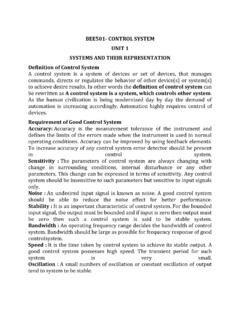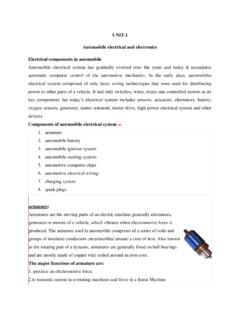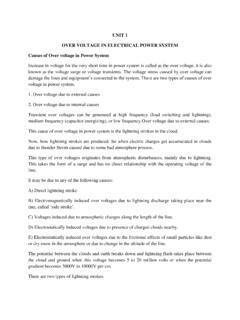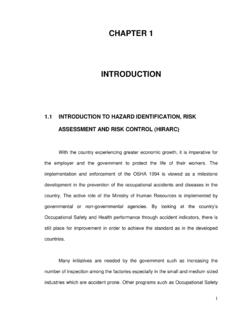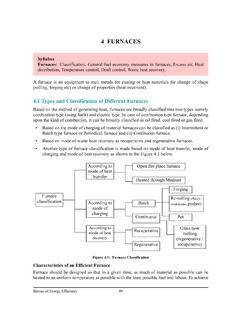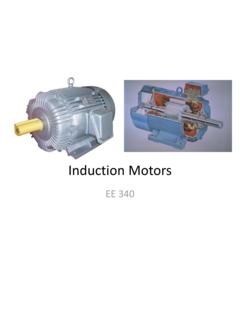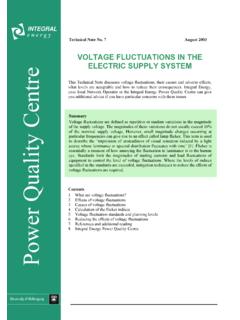Transcription of INTRODUCTION TO POWER QUALITY - Bharath Institute of ...
1 CHAPTER 1 INTRODUCTION TO POWER QUALITY INTRODUCTION This chapter reviews the POWER QUALITY definition, standards, causes and effects of harmonic distortion in a POWER system. DEFINITION OF ELECTRIC POWER QUALITY In recent years, there has been an increased emphasis and concern for the QUALITY of POWER delivered to factories, commercial establishments, and residences. This is due to the increasing usage of harmonic-creating non linear loads such as adjustable-speed drives, switched mode POWER supplies, arc furnaces, electronic fluorescent lamp ballasts etc.[1]. POWER QUALITY loosely defined, as the study of powering and grounding electronic systems so as to maintain the integrity of the POWER supplied to the system.
2 IEEE Standard 1159 defines POWER QUALITY as [2]: The concept of powering and grounding sensitive equipment in a manner that is suitable for the operation of that equipment. In the IEEE 100 Authoritative Dictionary of IEEE Standard Terms, POWER QUALITY is defined as ([1], p. 855): The concept of powering and grounding electronic equipment in a manner that is suitable to the operation of that equipment and compatible with the premise wiring system and other connected equipment. Good POWER QUALITY , however, is not easy to define because what is good POWER QUALITY to a refrigerator motor may not be good enough for today s personal computers and other sensitive loads. DESCRIPTIONS OF SOME POOR POWER QUALITY EVENTS The following are some examples and descriptions of poor POWER QUALITY events.
3 Fig. Typical POWER disturbances [2]. A voltage sag/dip is a brief decrease in the line-voltage of 10 to 90 percent of the nominal line-voltage. The duration of a sag is cycle to 1 minute. Common sources of sags are the starting of large induction motors and utility faults. A voltage swell is a brief increase in the line-voltage of 110 to 180 percent of the nominal line-voltage for duration of cycle to 1 minute. Sources of voltage swells are line faults and incorrect tap settings in tap changers in substations. An impulsive transient is a brief, unidirectional variation in voltage, current, or both on a POWER line. The most common causes of impulsive transients are lightning strikes, switching of inductive loads, or switching in the POWER distribution system.
4 These transients can result in equipment shutdown or damage, if the disturbance level is high enough. The effects of transients can be mitigated by the use of transient voltage suppressors such as Zener diodes and MOVs (metal-oxide varistors). An oscillatory transient is a brief, bidirectional variation in voltage, current, or both on a POWER line. These can occur due to the switching of POWER factor correction capacitors, or transformer ferroresonance. An interruption is defined as a reduction in line-voltage or current to less than 10 percent of the nominal, not exceeding 60 seconds in length. Another common POWER - QUALITY event is notching, which can be created by rectifiers that have finite line inductance.
5 Voltage fluctuations are relatively small (less than 5 percent) variations in the line-voltage. These variations can be caused by cycloconverters, arc furnaces, and other systems that draw current not in synchronization with the line frequency. Such fluctuations can result in variations in the lighting intensity due to an effect known as flicker which is visible to the end user. A voltage imbalance is a variation in the amplitudes of three-phase voltages, relative to one another. HARMONICS AS POWER QUALITY PROBLEM Harmonic disturbances come generally from equipment with a non-linear voltage/current characteristic. Nowadays a large part of industrial, commercial and domestic loads is non-linear, making the distortion level on the low-voltage supply network a serious concern.
6 As time goes on, more and more equipment is being used that creates harmonics in POWER systems. Conversely, more and more equipment is being used that is susceptible to malfunction due to harmonics. Computers, communication equipment, and other POWER systems are all susceptible to malfunction or loss of efficiency due to the effects of harmonics. For instance, in electric motors, harmonic current causes AC losses in the core and copper windings. This can result in core heating, winding heating, torque pulsations, and loss of efficiency in these motors. Harmonics can also result in an increase in audible noise from motors and transformers and can excite mechanical resonances in electric motors and their loads.
7 Harmonic voltages and currents can also cause false tripping of ground fault circuit interrupters (GFCIs). These devices are used extensively in residences for local protection near appliances. False triggering of GFCIs is a nuisance to the end user. Instrument and relay transformer accuracy can be affected by harmonics, which can also cause nuisance tripping of circuit breakers. Harmonics can affect metering as well, and may prompt both negative and positive errors. High-frequency switching circuits such as switching POWER supplies, POWER factor correction circuits, and adjustable-speed drives create high-frequency components that are not at multiples of line frequency.
8 Harmonic distortion can be considered as a sort of pollution of the electric system which can cause problems if the sum of the harmonic currents exceeds certain limits. HARMONICS AND THEIR CLASSIFICATION A harmonic is defined as a component with a frequency that is an integer multiple of the fundamental frequency. The harmonic number or harmonic order indicates the harmonic frequency. The ratio of harmonic frequency to fundamental frequency is harmonic order. Triplen harmonics are the harmonics whose orders are multiples of three. Zero-sequence harmonics are also called homopolar harmonics. In a three-phase system homopolar currents are a sum in the neutral conductor. Interharmonics are voltages or currents with a frequency that is a non-integer multiple of the fundamental frequency.
9 Another term is used namely, subharmonic, which does not have any official definition. It is a particular case of an inter harmonic with a frequency less than the fundamental frequency. QUANTITIES DESCRIBING VOLTAGE AND CURRENT DISTORTION Voltage/current distortion can be characterized in either the time or the frequency domain. Description in the time domain consists of finding the differences between the actual distorted waveform values and the reference sinusoidal waveform values. The difficulty in determining these differences by means of measurement causes this method of description is seldom used. The distortion description in the frequency domain is commonly accepted.
10 Individual Harmonic Distortion (IHD) It is the ratio between RMS value of individual harmonic and the rms value of the fundamental component of a wave form. IHDn=InI1 x 100 ( ) where In is the amplitude of current harmonic n and I1 is the amplitude of fundamental current . Total Harmonic Distortion(THD) The ratio of value of the sum of all the harmonic components up to a specified order to the value of the fundamental component is called total harmonic distortion and can be represented as =100 In2I12 =2 ( ) I1, I2, I3, I4,.. In, are values of harmonics 1,2,3,4.
